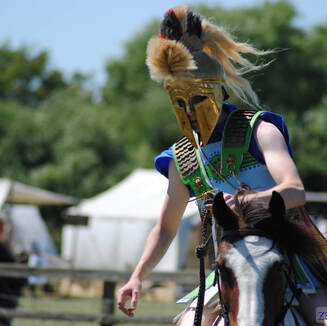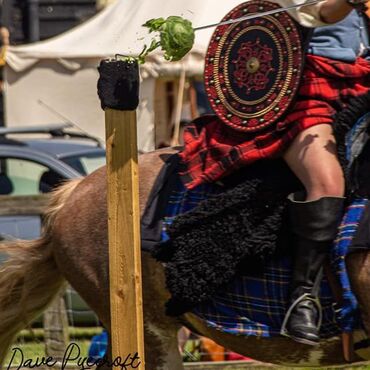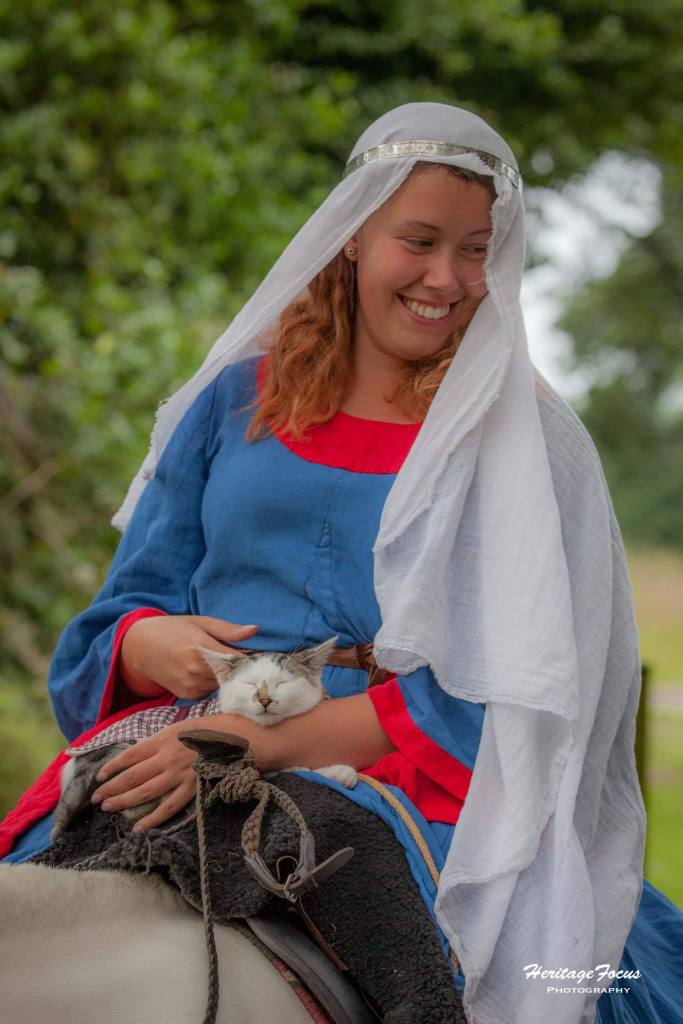A man fighting from horseback had the advantage of increased mobility, greater height and speed over an opponent on foot, as well as a shock factor that often-had psychological impacts on the enemy. For these reasons, the cavalry was greatly appreciated and exploited in times of war. Below are the periods of history we specialise in, however, if you don’t see your desired era get in touch and we will see how we can accommodate your needs.
A N C I E N T G R E E C E

The era of vengeful Gods and Epic Poetry, Ancient Greece is not a period to miss off your history lessons. If you've ever been to a museum with any kind of Greek display you'll have seen depictions of horses in war on the side of cracked vases and plates.
When they were first introduced to Greece they were incredibly expensive to own and were so prized they were often fed a luxurious diet of wheat and wine (!).
It was the famous Alexander the Great who made horses commonplace in the army and harnessed the full might and majesty of these animals in times of war.
When they were first introduced to Greece they were incredibly expensive to own and were so prized they were often fed a luxurious diet of wheat and wine (!).
It was the famous Alexander the Great who made horses commonplace in the army and harnessed the full might and majesty of these animals in times of war.
W E S T E R N H I G H M E D I E V A L E R A
1066 - 1307

During this era the heavy cavalry became the focus of military development. Armed with lances, swords, shields and heavy metal armour, the cavalrymen were made up from the elite of society. This was mainly due to the fact only the rich could afford not only a horse, but the enormous amounts of metal weaponry and education is took to become a mounted knight. These imposing figures were prized during wartime due to the fact their terrifying presence would often cause the infantry to break and scatter, most often just from pure fear.
Within this large period, there are lots of fantastic historical events to choose from. The Crusades, for instance, really show off the full scope of the mounted warriors potential. With our riders portraying both Eastern and Western forces, not only will you see the full effect of the heavy cavalry but also the tactics of the Eastern light and medium cavalry. For example, horse archers could cover enemy troops with arrows from a distance and never have to engage in hand to hand combat, rendering the infantry almost useless against them.
If you are looking for grandeur and splendour then the late 13th century and the Baron Wars are another great opportunity to see the skill of the heavy mounted warrior. Decked out in their brightly coloured heraldic caparisons, full face helmets and lances, our riders can create not only an exhilarating show but a beautiful one.
Within this large period, there are lots of fantastic historical events to choose from. The Crusades, for instance, really show off the full scope of the mounted warriors potential. With our riders portraying both Eastern and Western forces, not only will you see the full effect of the heavy cavalry but also the tactics of the Eastern light and medium cavalry. For example, horse archers could cover enemy troops with arrows from a distance and never have to engage in hand to hand combat, rendering the infantry almost useless against them.
If you are looking for grandeur and splendour then the late 13th century and the Baron Wars are another great opportunity to see the skill of the heavy mounted warrior. Decked out in their brightly coloured heraldic caparisons, full face helmets and lances, our riders can create not only an exhilarating show but a beautiful one.
E A S T E R N C R U S A D E S

As mentioned above, when portraying the Crusades our team can provide representation for the East as well as the Western forces. Primarily our looks and the battle tactics we engineer in our battle recreations are based off of Saladin's famous army. Salah al-Din Yusuf ibn Ayyub, the Muslim sultan of Egypt and Syria, famously defeated a large army of Crusaders in the Battle of Hattin and captured the city of Jerusalem in 1187. His military skills are largely celebrated by historians and so are a perfect focus for us to demonstrate to the public the unique advantages weapons such as archery and javelins have from horseback.
T H E J A C O B I T E R E B E L L I O N
C.1745

Within this era we primarily portray the Bagot’s Hassars. Also known as the Scotch Hussars, they fought in the service of Bonnie Prince Charlie and since their bloody defeat at the Battle of Culloden, there has been no regular serving Scottish Hussars.
By the late 18th century period cavalrymen had discarded the use of armour which was ineffective against muskets and cannon fire, and instead focused on their increased mobility to quickly engage the infantry in close quarters so their guns would be ineffective. The Bagot’s Hussars wore tartan trews, often trimmed with leather on the inner leg to prevent wear from riding, long riding boots, frock coat, shirt and waistcoat. Their weapons consisted of a basket-hilted sword, targe and musket or carbine.
We do also have a few riders who are dedicated to portraying the government forces, so we can recreate battles in this era.
By the late 18th century period cavalrymen had discarded the use of armour which was ineffective against muskets and cannon fire, and instead focused on their increased mobility to quickly engage the infantry in close quarters so their guns would be ineffective. The Bagot’s Hussars wore tartan trews, often trimmed with leather on the inner leg to prevent wear from riding, long riding boots, frock coat, shirt and waistcoat. Their weapons consisted of a basket-hilted sword, targe and musket or carbine.
We do also have a few riders who are dedicated to portraying the government forces, so we can recreate battles in this era.
T H E N A P O L E O N I C W A R S
1803 - 1815

Within the Napoleonic Era we portray the Black Brunswick Hussars. The hussar cavalry wore a black, blue collared dolman, sometimes with a black pelisse, and a black Shako with a skull and cross bones emblem. Traditionally the Hussars were equipped with sabres and pistols, though at times carried larger firearms like muskets or carbines.
The Black Brunswick Hussars fought on the allies side against Napoleons forces. Their title originates from Duke Frederick William, Duke of Brunswick-Lüneburg, though the “black” aspect was a nickname given to them due to their uniforms. The Black Brunswickers captured Victorian England’s imagination by earning themselves a fearsome reputation over the following decade. They took part in many significant battles including the pre-Waterloo engagement at Quatre Bras on 16 June 1815, where the Duke lost his life, and fought at Waterloo itself in honour of the Dukes memory. Due to their popularity they can often be found in a lot of famous British stories and paintings from the era.
The Black Brunswick Hussars fought on the allies side against Napoleons forces. Their title originates from Duke Frederick William, Duke of Brunswick-Lüneburg, though the “black” aspect was a nickname given to them due to their uniforms. The Black Brunswickers captured Victorian England’s imagination by earning themselves a fearsome reputation over the following decade. They took part in many significant battles including the pre-Waterloo engagement at Quatre Bras on 16 June 1815, where the Duke lost his life, and fought at Waterloo itself in honour of the Dukes memory. Due to their popularity they can often be found in a lot of famous British stories and paintings from the era.
T H E V I C T O R I A N S
1837 - 1901

The Victorian era refers to the part of history that happened under Queen Victoria. You might know from your history lessons that this is a period of great change and the height of the British Empire.
For horses this is an incredibly interesting time. At the beginning of the era, much like in the Napoleonic Era, horses are used for transport, pleasure and war. But towards the end horses begin to be seen more as a luxury for pleasure rather than a necessity in many circles. Women's sport on horseback finds a great new rush of popularity during this era from racing to shooting. In times of war horses begin to be used as a means of getting soldiers to the battle ground as quickly as possible, before dismounting and fighting on foot, though it was not until WW1 that soldiers truly realised that weaponry had far advanced the method of mounted combat.
In particular we focus on the Boer Wars in partnership with a range of different groups, and the leisure side of owning horses in this period.
For horses this is an incredibly interesting time. At the beginning of the era, much like in the Napoleonic Era, horses are used for transport, pleasure and war. But towards the end horses begin to be seen more as a luxury for pleasure rather than a necessity in many circles. Women's sport on horseback finds a great new rush of popularity during this era from racing to shooting. In times of war horses begin to be used as a means of getting soldiers to the battle ground as quickly as possible, before dismounting and fighting on foot, though it was not until WW1 that soldiers truly realised that weaponry had far advanced the method of mounted combat.
In particular we focus on the Boer Wars in partnership with a range of different groups, and the leisure side of owning horses in this period.
W O M E N O N H O R S E B A C K
Whilst our primary focus is on demonstrating the battle techniques of these eras, we do also portray women through the ages on horseback. Women were extremely good riders, sitting astride for most of the period under large horses, and took part in races, hunting, birds of prey competitions, and archery.


